Types of air conditioners for apartments: technical features + recommendations for buyers
Do you want to improve your living conditions and make them more comfortable by purchasing modern climate control equipment? Agree that with all the variety of offers from different manufacturers, it’s easy to get confused. Have you decided to choose the best technology option for yourself, but don’t know where to start?
We will help you in this matter - the article discusses the types of air conditioners for apartments and any other housing. It is important that the purchase is preceded by familiarization with such equipment, its features and parameters that you need to pay attention to when choosing.
The article also contains visual photographs and video recommendations for choosing an air conditioner, taking into account the characteristics of a particular home.
The content of the article:
Classification of climate control equipment
Most people call all the variety of climate control equipment air conditioners, but based on their design, the range can be divided into two groups.
One category includes monoblock products, that is, consisting of one body where everything necessary is located.
And the second includes climate control equipment, consisting of several parts: external and internal. Let's take a closer look at the features of each of the most popular types of air conditioners.
Window and mobile monoblocks
In this case, installation takes place in the opening of a window or wall, which determined the name. This installation method provides window air conditioners a number of advantages, among which the most important are compactness and relatively low cost.
There are also significant drawbacks, for example, noise is increased, and performance is moderate.
In addition, in winter, cold air will enter the room. The reason for this phenomenon is that there is no way to isolate the room from the external environment.
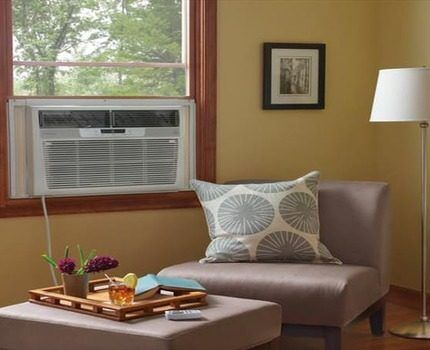
There are also some difficulties in installation, since an air conditioner of this type requires a previously provided niche; if it is absent, installation is impractical. For example, it is unlikely that the owner will have a desire to additionally buy a metal-plastic window of the desired design.
All of the above indicates that such units are not the most practical, and therefore not in demand.
A specific product is mobile type of air conditioners. The reason is that they, like window ones, are monoblock. That is, all the necessary components are placed in one housing.
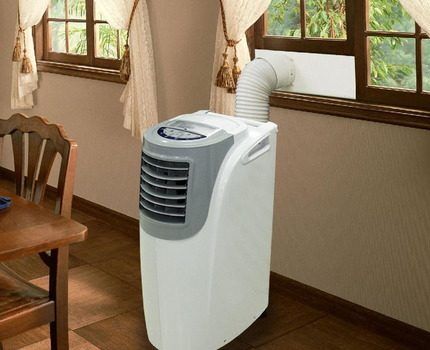
As a result, noisy structural elements are located in the room, which affects the comfort of living, and negatively.
But products of this type do not need to be installed, which allows for significant savings; this feature also makes it possible to move the unit indoors, but with restrictions.
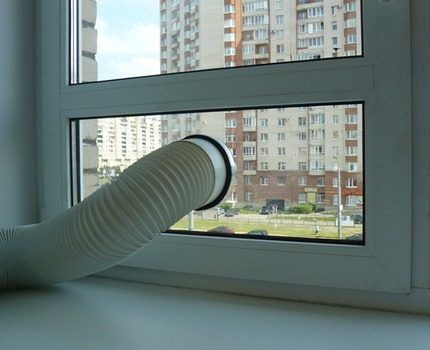
Since the inconvenience is caused by the hose through which hot air is discharged outside the apartment. This structural element must be displayed out the window. Read about the best representatives of mobile air conditioners Further.
Types of split systems
Cooling of indoor air can be carried out by products traditionally also called air conditioners, but consisting of two parts. It is correct to classify such climate control equipment into the category of split systems.
It is this type that is best known to consumers - such equipment is most often used in ordinary apartments.
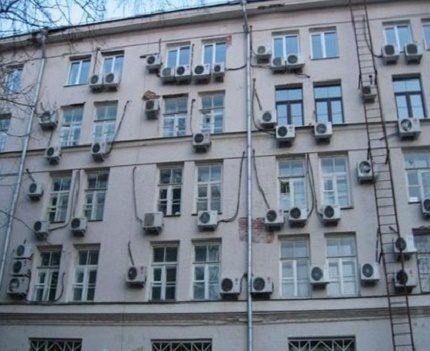
A split system, unlike monoblock air conditioners, consists of at least two parts. Which include indoor and outdoor units. Their name indicates the installation location.
The most important advantage of such equipment is power. Design features allow you to move the noisiest structural element (compressor) outside.
As a result, developers have the opportunity to increase productivity without the risk of reducing living comfort.
Additionally, split systems are divided into the following subtypes:
- wall;
- floor;
- channel;
- cassette.
The listed names are assigned due to the peculiarities of the location of the indoor units and the supply of cooled air. So, wall-mounted variety is the most popular. The reason is the convenient location of the block, since it does not take up free space.
But floor option distributes air masses an order of magnitude more evenly, which makes it more effective.In addition, such products do not need to be installed, which is also an advantage, as it allows for significant savings.
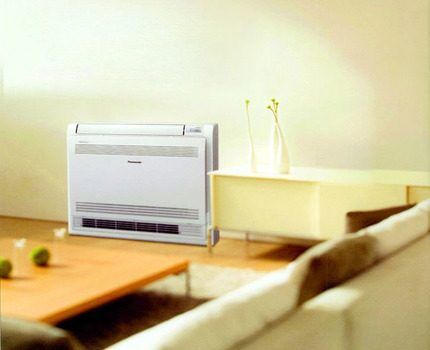
Duct split systems will be the best option for large apartments if the owners are willing to spend a large sum on installation.
Since a feature of this subspecies is the laying of pipes through which air is transported, installation is carried out in the space between the suspended and main ceilings. This allows you to hide all structural elements and has a positive effect on the design.

Cassette systems similar to the previous variety, the only difference is the absence of pipes. That is, cooled air is supplied through an opening at the bottom of the indoor unit, which is called a cassette.
Its peculiarity is its standard size, which is always 600x600 mm, and these are the usual parameters of ceiling tiles. This is done so that the unit can be easily disguised, which is also facilitated by the decorative grille.
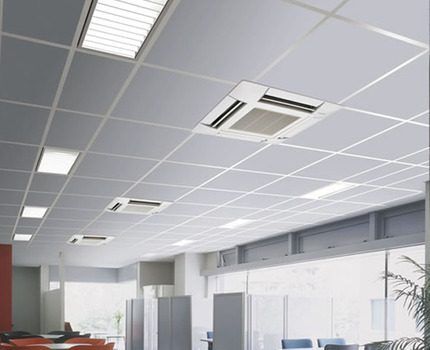
Systems cassette type are used to organize cold air blowing into large rooms.
Multi-unit climate control technology
If you need to maintain a microclimate in several rooms, it is often used multi-split system, which is one external unit that supplies the required volume of air to several internal ones.
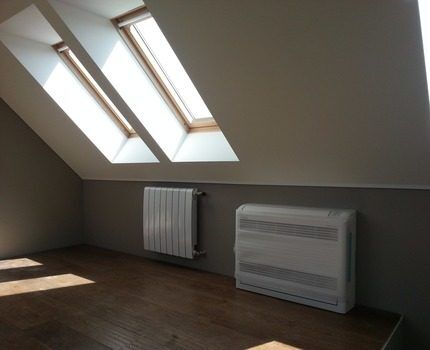
Main selection criteria
To understand which type of air conditioner/split system will be optimal for an apartment, you need to compare their main characteristics. And you always need to start with productivity, since only this will ensure comfortable living and avoid overpayment.
Parameter No. 1 - equipment power
You should know that monoblock air conditioners are designed to cool mainly small rooms, the area of which does not exceed a moderate 15-35 square meters.
Their analogues, which are split systems, can cope with supplying a sufficient amount of air to all rooms of the apartment, even when its area reaches an impressive 150-500 square meters.
But only expensive duct and multi-split systems can achieve these indicators.
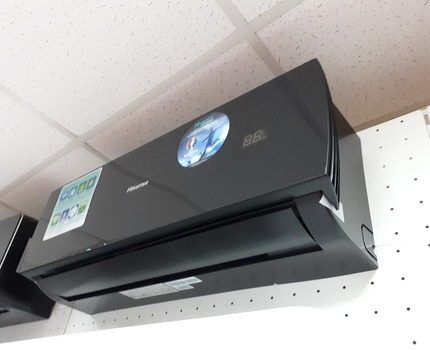
In most cases, the capacity of multi-unit units can cool up to 80 square meters. And for owners of small apartments, split systems are made, the performance of which does not exceed the capabilities of window, mobile air conditioners.
As a result, we can conclude that if you have a large apartment, only complex multi-unit climate control equipment can provide comfortable living.
And if the area is small, then a product of any type will do. Although split systems have a larger power reserve.
We also recommend reading our other article, where we talked in detail about how to calculate the power of an air conditioner. More details - go to link.
Parameter No. 2 - comfort of living
For most buyers, comfort in an apartment is a fundamental parameter, so you should approach issues such as noise responsibly.
It was stated above that the noisy units of monoblock air conditioners are located indoors, while those of split systems are located outside. As a result, the latter category is the most preferred.
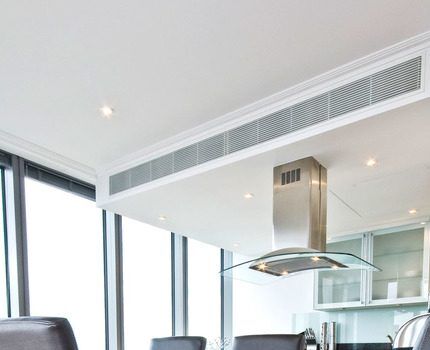
But you should know that monoblocks are developed taking into account current standards regulating such a parameter as sound pressure, so they are clearly not losing the battle for attractiveness.
And the best way to identify the best option is experimental, that is, all you need is to hear how the model you like sounds.
Mobile air conditioners have a drawback, which is significant and unique to them. It is expressed in the need to empty the container with condensate every few hours.
This feature arose due to the lack of access to the street - split systems and their window analogues have access to the street, where the liquid flows, but the mobile version is deprived of this opportunity.
You should know that monitoring the filling of the container and its emptying are unpleasant procedures. Still, the way out of the described situation is simple - purchasing the latest generation units, which are “trained” to independently supply liquid to the heat exchanger, where it evaporates.
Also, until recently, mobile air conditioners were distinguished by the fact that they were unable to comply with a preset program. As a result, real indicators could well differ from the specified ones by several degrees, which did not contribute to comfort in any way.
But this shortcoming is increasingly considered a relic of the past. Thus, several years ago they began producing a generation of monoblock air conditioners capable of operating with minimal errors of no more than 1 °C.
However, we must not forget that such capabilities are not inherent in all products.
Parameter No. 3 - equipment mobility
Although, judging by the name, one type of climate control equipment should have an overwhelming advantage in this segment, everything is not so simple. The reason is that, as with comparing other characteristics, everything is relative.
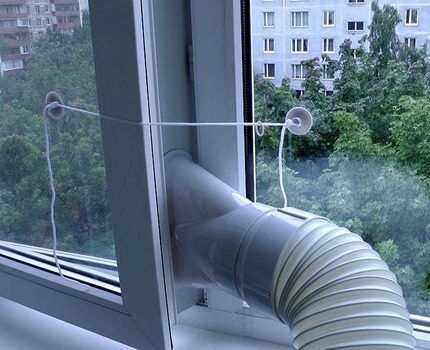
Thus, the capabilities of mobile air conditioners are limited by the presence of a large hose, which must always have access to the street. Otherwise, the removal of hot masses will not be possible, and as a result, air cooling will be ineffective.
This feature makes this type of equipment only conditionally mobile - it is unlikely that the owner will have the desire to regularly move it from the kitchen to the bedroom and vice versa.
But it is convenient to transport a mobile air conditioner to another apartment or to a country house during seasonal residence. This can be done in the trunk of a car or even manually. This will not work with split systems.
Parameter No. 4 - model reliability
All varieties have sufficient durability, which allows them to be used for their intended purpose for many years. But there are a number of features that affect this parameter. Thus, the external units of split systems are located outside the house, which excludes the possibility of their year-round operation.
If you do not listen to this rule, then the unit’s resource reserve will only last for a couple of years, and this is at best, and they often break down during even one launch carried out at temperatures below -5 ° C.
The reason is that air conditioners are not designed to work in cold weather. And the adaptation attempts made by the developers are so far unsuccessful and frozen lubricant leads to wear and tear of the loaded structural elements.
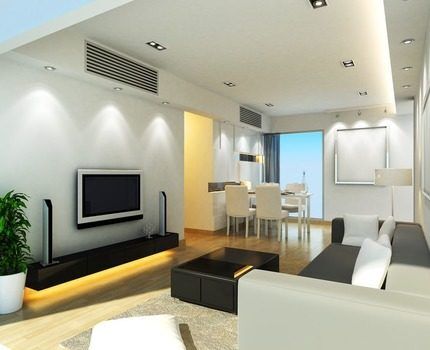
Additionally, the durability of external units can be affected by precipitation and other difficult operating conditions.All of the above does not affect the reliability of mobile air conditioners, since their workplace is traditionally located inside the apartment.
Parameter No. 5 - other important options
When comparing characteristics, you should also remember that all existing types of air conditioners, adapted for cooling an apartment, in addition to the main functions, are capable of performing a number of others.
For example, heating rooms, purifying the air, while the degree of filtration varies.
Often, climate control equipment is equipped with humidifiers and ionizers. Process automation is increasingly being used. The above makes air conditioners more functional and increases the comfort of living.
But there is also a bit of negativity in the improved functionality - with an increase in the number of functions, the cost of the product increases.
When choosing the type of product, you should take into account the amount of additional costs, the reason is that they can reach impressive sizes.
For example, installation of air conditioners often costs a lot of money - 20-30% of the price of the equipment itself. Anti-vandal protection, awnings, visors can increase the cost of purchasing split systems by another 10-20%.
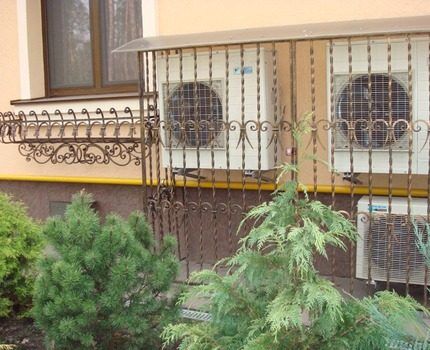
You can install the external unit yourself, but for this you need to have a specialized tool and have some skills, otherwise it is better to entrust such work to specialists.
Mobile air conditioners are cheaper in this regard, but the best option for mounting their hose is to insert it into a window, which also costs money.
In this case, it is not worth saving, since the headwind will return hot air to the apartment, which will make the cooling procedure ineffective and expensive.
Conclusions and useful video on the topic
Types of air conditioners, their features and operating principles:
Expert advice on choosing air conditioners:
Modern climate control equipment is practical, but the existing variety of types and models makes it difficult to choose. Nevertheless, solving this problem is quite simple - take a sheet of paper and list all the advantages and disadvantages of a product. And compare the result with your requirements, with the features and dimensions of the apartment.
Which air conditioner did you choose? What were you guided by? Are you satisfied with the work of the equipment? Please share your opinion in the block located below the article.




The best option for an apartment building, of course, would be a single system with distribution across apartments. But, unfortunately, the trend is that not only air conditioning, but also hot water supply and heating are becoming individual. Centralized networks, especially in small towns, are deteriorating, and the population is buying up boilers and electric convectors.
What a dreamer you are) It’s hard to imagine that someone would create a unified system with wiring for apartments, if only because some people are naturally cold and are not going to install air conditioners at all. And on the main topic - I have a mobile air conditioner at home. I decided that this was the most economical and reasonable option; I didn’t have to damage the outside wall to attach the equipment.
Today's air conditioners, Denis, are becoming more and more economical - this is the main technical trend.The vector you indicated is correct for Russia.
However, while brands are improving split systems, some developers have realized that there is no need to cool huge rooms - it is necessary to create a local microclimate. The University of California, for example, has developed a fabric lined with miniature interconnected elements that “generate” cold - using the Peltier effect. Technologically, the invention is ready for implementation - it is possible to start sewing clothes from temperature-regulating fabric.
I have attached a screenshot with a piece of such fabric.